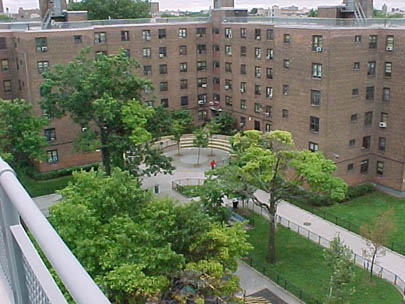
Marcy Subsidized Housing Projects, Brooklyn, New York [Source: brooklyn.com]
This model of public housing encompassing public space effectively suppresses the identities of inhabitants down to bleak facades hiding unsuitable and often dangerous open space.

Mock Window on Vacant Building in Washington, D.C., before and after decals by Home Illusions. Douglas Development
… the Bronx began to burn in about 1970. Some of the fires were accidents, the inevitable result of decaying electrical systems. Many were set by landlords who would then collect the insurance money. Often they would sell the building–whether it was still inhabited or not–to “finishers” who would strip out the electrical wiring, plumbing fixtures, and anything else that could be sold for a profit before torching it. “Sometimes there’d be a note delivered telling you the place would burn that night,” one man who lived through the period told me. “Sometimes not.” People got used to sleeping with their shoes on, so that they could escape if the building began to burn. [Source:
http://www.washingtonmonthly.com/features/1999/9904.worth.bronx.html]
Today, the local economy has picked back up substantially with the influx of planning, architecture and consumers. Urban reformation of vacant buildings and communal amenities positively correspond with the functionality of a neighborhood. And thus, these drivers should continue to evolve in unified forethought toward urban design not solely a scattered afterthought to save broken communities. The bottom line is capital. Wealthier neighborhoods invite a richer population, contrasting to middle and low income communities that progressively become unsafe. If these communities remain reliant on the wealthy to save them, unfortunately, they will continue to die out. Architecture is unequipped to tackle this challenge alone, hence the the hesitance to consider social issues as integral, often categorizing them as public works charity. The role of the architect does, however, have the capacity to gather economists, scientists, and engineers in a collective design process. Together with other applicable industries, there is potential for a cost effective solution to target the division of classes and promote diversity by supporting ministries and associations of housing, education, and public health with economical architectural alternatives. Potential Affordability of Green Technology Technological systems seem to exist exponentially in what is being referred to as our first technological revolution. Almost everyday we can be made aware of a new start-up using the internet as a platform to share information in, literally, a click of a button. Architecture is said to be able to change with the times but the times are changing much more rapidly and meanwhile architecture is dancing along the outskirts, still trying to decide if it should or can jump in. It should. It can! By expanding its role to incorporate cost effective technology and material, an advanced interdisciplinary architecture can develop a framework for the design of safer urban communities. Generally speaking, architectural technological devices, such as the typically applied solar panels and wind turbines, come onto the market at a fairly high cost; Certainly, they are not immediately feasible for large-scale urban revitalization. However, over time, the cost of such devices decrease substantially due to competition and ease of production. Granted some systems may remain out of budget, but there is higher probability for more affordable options when there are more options in general. Presently, it takes much less time for a new solution to become a widely used, and therefore a much more affordable one because new technologies are being generated and shared so quickly. The internet and its open source paradigm is shared all around the world. Having internet access has become a primary priority as an educational resource and hub for social interaction. It is so heavily intertwined in our present day lives and is dynamic enough to transition into our future. Similarly, the primary elements of nature have proven timeless and increasingly effective in terms of generating power from water, solar, wind, soil, etc. I find it compelling to look at these basic elements in the same light alongside advanced technologies because it defies the bounds of time – primitive versus futuristic – yet they work so well together. The most appealing assets of both the internet and natural power is decisively its widespread accessibility, affordability (sometimes they are even free) and ability to customize functions. I believe there is some connection to discover in the exploration of sharing via network and applying natural systems for an economical architectural alternatives. Of course, transitioning to a macro-scale analysis of this brewing idea, there remains the issue of gentrification. However, natural systems hint at modest opportunities to be self-sufficient in communities that need local solutions, not grandeur political schemes in favor of the highest bidder or big corporations. So although the solution itself may not yet be clearly defined, its potential to respond to the effects of urban decay, is enough to warrant further research.